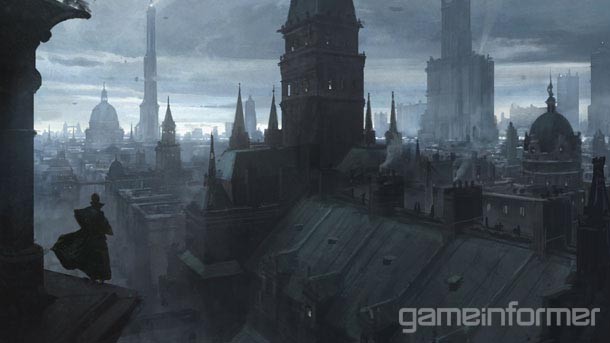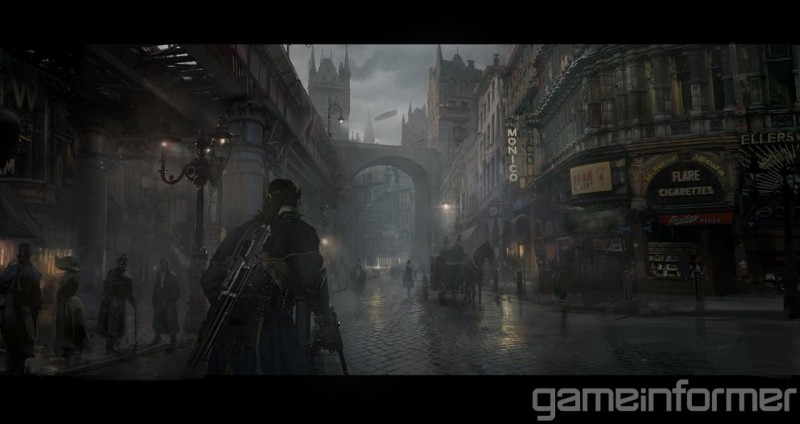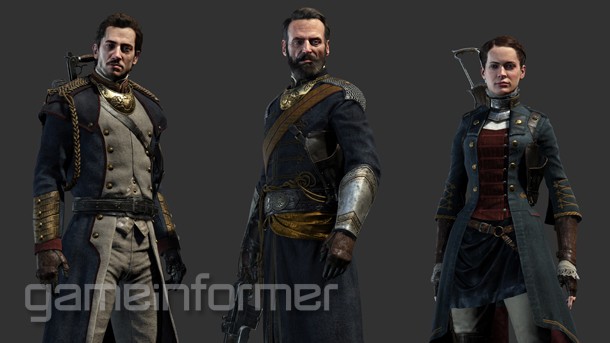The History-Bending Art Of The Order: 1886

Ready At Dawn created some of the most visually impressive handheld games ever seen. The PSP titles God of War: Chains of Olympus and God of War: Ghost of Sparta astounded fans by not only feeling like their console brethren, but looking remarkably close to the PS2 titles. Ready At Dawn pulled off the feat with its combined technical and artistic chops. With Kratos’ universe behind them and the creative floodgates open, the developer is free to flex its artistic muscle with its brand new PlayStation 4 game, The Order: 1886. Ready At Dawn created its alternate version of 1880s London by visiting the iconic city, researching the era’s garb, and taking an exotic, yet grounded, approach to its creative weaponry. We spoke with Nathan Phail-Liff, art director on The Order: 1886, about creating the art behind this stunning next-gen world.
Before we dive into the art behind the game, it’s important to know the game’s basic premise. If you’ve already read our cover story, then you know that the knights of The Order: 1886 are based the historic Knights of the Round Table. Galahad, Lady Igraine, Sir Percival, and historic icon Lafayette are the heavily armed and expertly trained protectors of England. In The Order, these knights suppress an uprising rebel force representing the downtrodden citizens of London, as well as other more outlandish threats. Ready At Dawn’s version of 1886 London is recognizable, but the developer has put its own twist on the era’s architecture and technology.

“The initial mood pieces we did at the very beginning of the project definitely had the alternate and fantastical push much further than it is today,” Phail-Liff says, describing early city concept pieces with dark, towering spires. “And it was cool. We still look back on it and think that those are really nice pieces, but one thing that we really wanted was to capture that sense of realism with a twist. If you look at London it’s pretty flat. It doesn’t have a lot of tall buildings, especially in that era. And so we tried to reign that back in so you look at the skyline, and you identify it as London but then there’s a few things that kind of stand out, like mooring towers where we’d have had a heavier reliance on airships in our alternate history. So there are certain things that give the feeling of London a twist, but at first glance it’s believable and relatable as London was.”
Another important step for making The Order’s alternate version of London was a team visit to England. “In terms of architecture and props in the world, it’s a huge amount of stuff from what we saw there pretty much ended up in the game,” Phail-Liff says.
Ready At Dawn wanted to visit London when it was gloomy and foggy, but unfortunately for the team the weather was uncharacteristically nice for that time of year. However, the developers gathered comprehensive notes and pictures detailing the rich collection of architecture spanning dozens of generations.

“On the art side, that’s also something we keep in mind when we’re designing sets, especially in the cities,” Phail-Liff says. “It’s like capturing that layer of history. It’s not like you go in and build Victorian London by using all Victorian buildings, you have that layer of the medieval and Tudor buildings. That sense of this hodgepodge of different architectural eras and styles mixed together, it’s what makes it look like a real believable city. That was something that was really, really helpful to see when we were on location.”
The team’s trip to London was important for capturing the vibe and structures of the city, but the developer turned to professional film costumers to get the period clothing right.
“We rented out space at a costume warehouse there that does period costumes for films, so we could pull everything from an actual historic constable outfit from Victorian times,” says Phail-Liff. “We had models that we’d dress up and basically do fashion photo-shoots from every single detail of the costume, so we got a wide range of classes and professions from actual period costumes. Beyond that reference gathering, there was a huge amount of research time invested in understanding the cuts and style of a dress used in the era across classes, and sourcing as many period-accurate textiles as we can, which we then scan and actually use to surface the characters. We’re hoping that, when the player experiences the game, it feels like everything is really believable and real and it doesn’t feel like a game costume – it really feels like a period film costume.”

Ready At Dawn is working hard to capture the essence of the era’s garb, but is taking liberties in designing the knights of the Order’s uniforms. In addition to their intricately detailed Victorian clothing, they also have knightly protection like metal greaves and gauntlets.
Like their clothing, the knights’ weaponry is a hybrid of ideas. The weapons these protectors wield are a fusion of authentic 1880s era technology and dangerously experimental designs. For example, the lightning-blasting arc gun may not exist in real life, but Ready At Dawn wants the device to appear believable. The team referenced real objects to create the cobbled together look of these vicious guns.
Garret Foster, tech director on The Order: 1886, says, “All those pieces of technology for the most part – especially with weaponry and things – were there in some capacity. You can find this guy in this part of the world invented this piece and this guy in [another] part of the world invented this piece. Someone could have conceivably [combined] the existing technology. That’s what a lot of the weapons are based on: ‘Well there was this guy in Eastern Europe that invented this and this in guy Britain invented this piece.’ They could have conceivably have met each [combined] those pieces together.”

The team’s goal to make these powerful weapons look like convincing pieces of machinery reinforces how different the artistic vision is from steampunk. Steampunk is popular in other alternate history visions of the world, featuring steam-powered gadgets, gaudy gadgets covered in gauges and valves, and stylish goggles.
“That word always has loaded meanings to us,” Phail-Liff says. “You have good steampunk and you have bad steampunk. I think what falls into what we would consider the bad category is when you’re adding random accoutrements to weapons just to fit an aesthetic, so we want to make sure that anything we design has a believable function to it.”
Further reinforcing The Order’s aesthetic distance from steampunk is the fact that combustion and electricity appears to be the common energy types in the world. “We’re not even emphasizing steam as particularly deviating technology,” Phail-Liff says.

Phail-Liff’s disinterest in slapping superfluous cogs and other gaudy gadgets to the game’s tech may stem from his past engineering job creating conceptual illustrations for NASA vehicles as a freelance artist.
“I think one thing I bring to the table is I have this fusion of technical background and art,” says Phail-Liff. “So I approach art form an engineering standpoint as well. As a kid, even just playing with Legos, I would constantly be designing and building things and trying to create imagined worlds from the ground up. Fusing those two things is great for working in the video game field, because it’s not just art. Art in the final product is only as good as the art it’s built upon.”
Like the layered architecture of London itself, Ready At Dawn is building upon the already artistically breathtaking city and turning it into something new and exciting. With this striking visual aesthetic in place, The Order: 1886 is one title Sony fans should keep their eyes on.
Be sure to check the hub below later this month to see how the power of the PlayStation 4 has unlocked new methods for creating this high-fidelity, intricate new world.

Get the Game Informer Print Edition!
Explore your favorite games in premium print format, delivered to your door.
- 10 issues per year
- Only $4.80 per issue
- Full digital magazine archive access
- Since 1991










